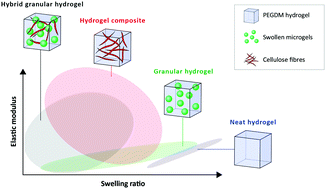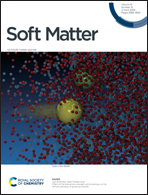Hybrid granular hydrogels: combining composites and microgels for extended ranges of material properties†
Abstract
Developing hydrogels with optimal properties for specific applications is challenging as most of these properties, such as toughness, stiffness, swelling or deformability, are interrelated. The improvement of one property usually comes at the cost of another. In order to decouple the interdependence between these properties and to extend the range of material properties for hydrogels, we propose a strategy that combines composite and microgel approaches. The study focuses first on tailoring the swelling performance of hydrogels while minimally affecting other properties. The underlying principle is to partially substitute some of the hydrogels with pre-swollen microgels composed of the same materials. Swelling reductions up to 45% were obtained. Those granular hydrogels were then reinforced with nano-fibrillated cellulose fibres obtaining hybrid granular materials to improve their toughness and to further reduce their initial swelling. Four different structures of neat, granular and composite hydrogels including 63 different hydrogel compositions based on 20 kDa poly(ethylene glycol)dimethacrylate showed that the swelling ratio could be tailored without significantly affecting elastic modulus and deformation performance. The results explain the role of the PEGDM precursors on the swelling of the microgels as well as the influence of the microgel and fibre contents on the final properties. Moreover, the precursors of hydrogels with similar mechanical or swelling performance were injectable with a wide range of complex viscosities from 0.1 Pa s to over 1000 Pa s offering new opportunities for applications in confined as well as in unconfined environments.



 Please wait while we load your content...
Please wait while we load your content...